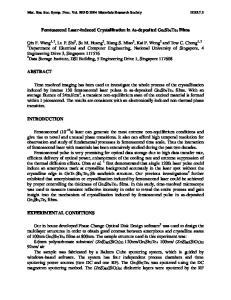Growth Temperature and Properties of Ge 4 Sb 3 Te 3 Films
- PDF / 105,928 Bytes
- 6 Pages / 612 x 792 pts (letter) Page_size
- 3 Downloads / 262 Views
D6.14.1
Growth Temperature and Properties of Ge4Sb3Te3 Films W. D. Song , L.P Shi, X. S. Miao, X. Hu, H.K. Lee, R. Zhao, J.F. Chong and T.C. Chong Data Storage Institute, Agency of Science, Technology and Research, DSI Building, No 5, Engineering Drive 1, Singapore 117608, SINGAPORE ABSTRACT The growth temperature and properties of Ge4Sb3Te3 thin films are presented in this paper. The critical growth temperature of Ge4Sb3Te3 is between 300 and 340 oC. The Ge4Sb3Te3 films can only be grown on a substrate below the critical growth temperature. The typical resistivity and carrier density are in the order of 10-4 Ωcm and 1021 cm-3 for crystalline phase. It has a rock salt crystal structure with a lattice constant of 0.602 nm. Ge4Sb3Te3 has a better thermal stability but a lower crystallization speed than Ge2Sb2Te5. INTRODUCTION Phase change material has a strong dependence of optical and electric properties upon its structure. Due to a difference in the reflectivities between the states, and a fast phase change induced by a pulsed laser, phase change materials can be used for rewriteable optical data storage [1, 2]. With a high resistance ratio between the states and a reversible phase change induced by an electric current, phase change materials are also very favorable for nonvolatile memory [3]. Typical phase change materials for rewriteable optical data storage and nonvolatile memory are Ge-Sb-Te or Ag-In-Sb-Te alloys. Previously, Ge-Sb-Te alloys such as Ge1Sb4Te7, Ge1Sb2Te4, Ge2Sb2Te5 and Ge4Sb1Te5 have been reported [1-6]. In this paper, the growth temperature and properties of Ge4Sb3Te3 thin films are presented and the results showed that Ge4Sb3Te3 is a promising candidate for applications in rewriteable optical data storage and nonvolatile memory. EXPERIMENTAL DETAILS The experimental setup consisted of the laser deposition system as discussed previously [7]. Here, the output beam from a KrF excimer laser, which operated at a wavelength of 248 nm and produced 30 ns pulses, was focused onto a rotating Ge2Sb2Te5 target using a lens. The target was mounted at 45° with respect to the laser beam. At a distance of 6 cm away from the target, three 5×10 mm2 single-crystal Al2O3 substrates were mounted onto a stainless steel holder using silver paste. These substrates were at a distance of 10 mm apart from each other. A background pressure of 2×10-6 Torr was achieved using a turbomolecular pump. The films were deposited at a laser fluence of 2 J/cm2 and at a repetition rate of 10 Hz. The growth temperature was between room temperature and 450 °C. After the growth, substrates were cooled down to room temperature at the same pressure. The crystal structures of thin films were characterized by x-ray diffractometry (XRD). The composition was studied by using X-ray photoelectron spectroscopy (XPS) while the electrical properties of thin films were analyzed by using four-probe measurement and Hall system.
D6.14.2
RESULTS AND DISCUSSION The compositions of thin films depend on the target material and the deposition condition
Data Loading...











